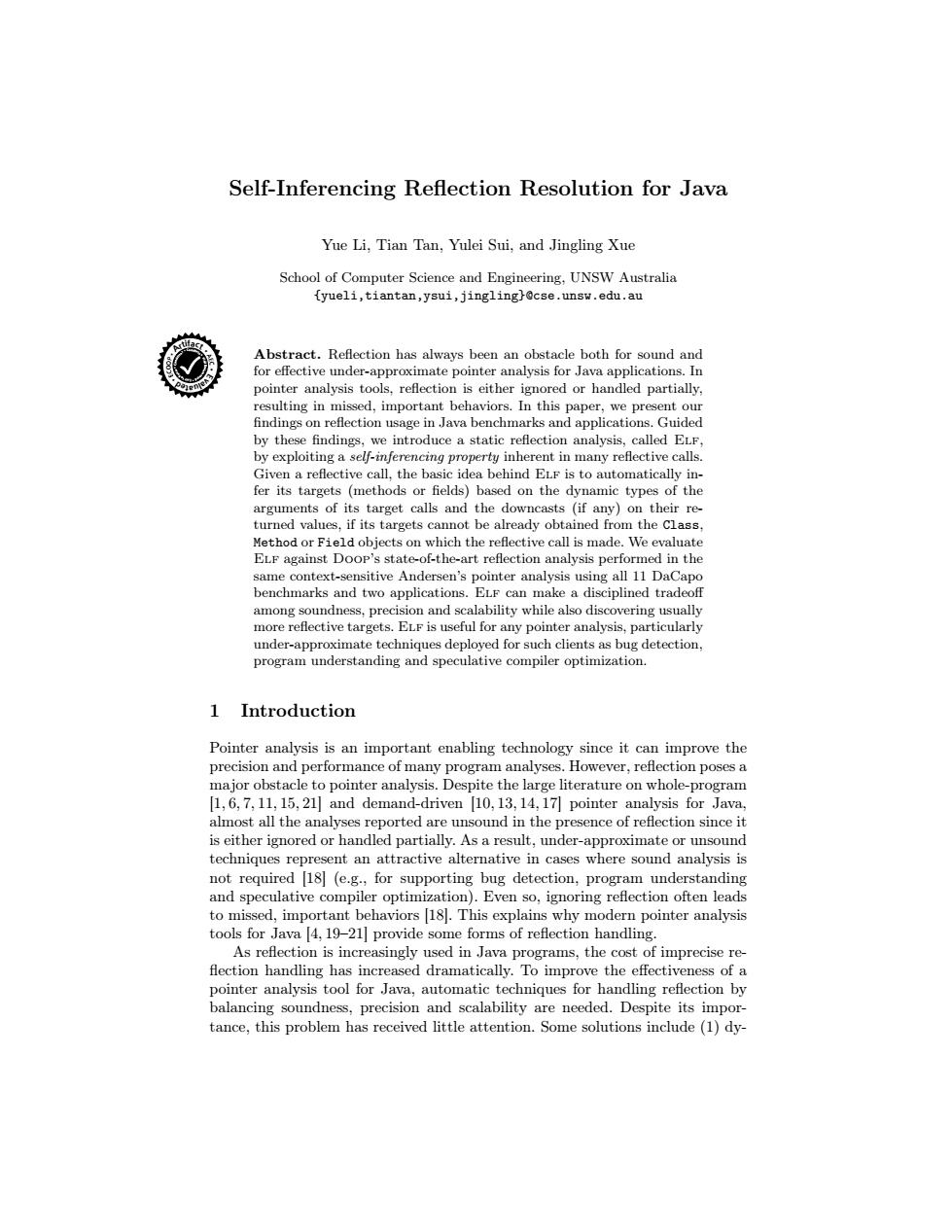正在加载图片...

Self-Inferencing Refection Resolution for Java Yue Li,Tian Tan,Yulei Sui,and Jingling Xue School of Computer Science and Engineering.UNSW Australia {yueli,tiantan,ysui,jingling}Ocse.unsw.edu.au Abstract.Reflection has always been an obstacle both for sound and for effective under-approximate pointer analysis for Java applications.In pointer analysis tools,reflection is either ignored or handled partially, resulting in missed,important behaviors.In this paper,we present our findings on reflection usage in Java benchmarks and applications.Guided by these findings,we introduce a static reflection analysis,called ELF, by exploiting a self-inferencing property inherent in many reflective calls. Given a reflective call,the basic idea behind ELF is to automatically in- fer its targets (methods or fields)based on the dynamic types of the arguments of its target calls and the downcasts (if any)on their re- turned values,if its targets cannot be already obtained from the class, Method or Field objects on which the reflective call is made.We evaluate ELF against Doop's state-of-the-art reflection analysis performed in the same context-sensitive Andersen's pointer analysis using all 11 DaCapo benchmarks and two applications.ELF can make a disciplined tradeoff among soundness,precision and scalability while also discovering usually more reflective targets.ELF is useful for any pointer analysis,particularly under-approximate techniques deployed for such clients as bug detection, program understanding and speculative compiler optimization. 1 Introduction Pointer analysis is an important enabling technology since it can improve the precision and performance of many program analyses.However,reflection poses a major obstacle to pointer analysis.Despite the large literature on whole-program [1,6,7,11,15,21]and demand-driven [10,13,14,17]pointer analysis for Java, almost all the analyses reported are unsound in the presence of refection since it is either ignored or handled partially.As a result,under-approximate or unsound techniques represent an attractive alternative in cases where sound analysis is not required 18(e.g.,for supporting bug detection,program understanding and speculative compiler optimization).Even so,ignoring reflection often leads to missed,important behaviors [18.This explains why modern pointer analysis tools for Java [4,19-21]provide some forms of reflection handling. As reflection is increasingly used in Java programs,the cost of imprecise re- flection handling has increased dramatically.To improve the effectiveness of a pointer analysis tool for Java,automatic techniques for handling reflection by balancing soundness,precision and scalability are needed.Despite its impor- tance,this problem has received little attention.Some solutions include(1)dy-Self-Inferencing Reflection Resolution for Java Yue Li, Tian Tan, Yulei Sui, and Jingling Xue School of Computer Science and Engineering, UNSW Australia {yueli,tiantan,ysui,jingling}@cse.unsw.edu.au Abstract. C onsistent * Complete * Well D ocumen et d t ysaE * o Reuse * * Eva ul det a * EC O O P * Artifact * AE C Reflection has always been an obstacle both for sound and for effective under-approximate pointer analysis for Java applications. In pointer analysis tools, reflection is either ignored or handled partially, resulting in missed, important behaviors. In this paper, we present our findings on reflection usage in Java benchmarks and applications. Guided by these findings, we introduce a static reflection analysis, called Elf, by exploiting a self-inferencing property inherent in many reflective calls. Given a reflective call, the basic idea behind Elf is to automatically infer its targets (methods or fields) based on the dynamic types of the arguments of its target calls and the downcasts (if any) on their returned values, if its targets cannot be already obtained from the Class, Method or Field objects on which the reflective call is made. We evaluate Elf against Doop’s state-of-the-art reflection analysis performed in the same context-sensitive Andersen’s pointer analysis using all 11 DaCapo benchmarks and two applications. Elf can make a disciplined tradeoff among soundness, precision and scalability while also discovering usually more reflective targets. Elf is useful for any pointer analysis, particularly under-approximate techniques deployed for such clients as bug detection, program understanding and speculative compiler optimization. 1 Introduction Pointer analysis is an important enabling technology since it can improve the precision and performance of many program analyses. However, reflection poses a major obstacle to pointer analysis. Despite the large literature on whole-program [1, 6, 7, 11, 15, 21] and demand-driven [10, 13, 14, 17] pointer analysis for Java, almost all the analyses reported are unsound in the presence of reflection since it is either ignored or handled partially. As a result, under-approximate or unsound techniques represent an attractive alternative in cases where sound analysis is not required [18] (e.g., for supporting bug detection, program understanding and speculative compiler optimization). Even so, ignoring reflection often leads to missed, important behaviors [18]. This explains why modern pointer analysis tools for Java [4, 19–21] provide some forms of reflection handling. As reflection is increasingly used in Java programs, the cost of imprecise re- flection handling has increased dramatically. To improve the effectiveness of a pointer analysis tool for Java, automatic techniques for handling reflection by balancing soundness, precision and scalability are needed. Despite its importance, this problem has received little attention. Some solutions include (1) dy-